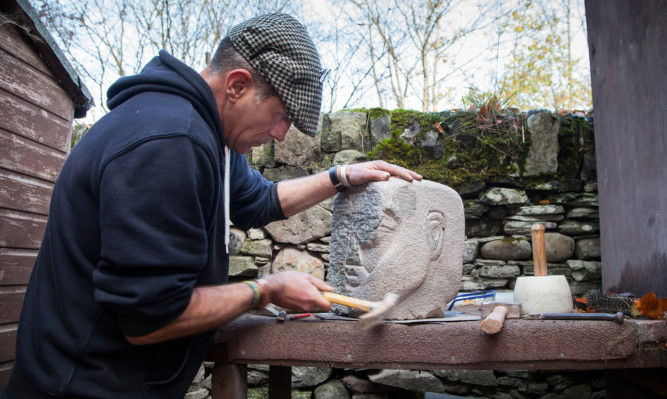An Angus sculptor has begun work on a headstone tribute to one of Scotland’s forgotten artists.
Historic Scotland awarded a memorial plaque to Adam Christie, known as “the gentle Shetlander”, at his grave in Montrose last year.
For nearly 50 years Christie was a patient at Sunnyside Hospital and was buried in a pauper’s grave at Sleepyhillock cemetery.
During his life at the asylum, he developed a skill for stone sculpting with a heavy old file and a six-inch nail, with a piece of broken glass to create a smooth finish on some parts of his sculptures.
His series of stone heads are now deemed to be some of Scotland’s finest examples of “outsider art”, and he is being used as a case study in a Glasgow University research into mental health and art.
Following the plaque’s installation, local historian Dave Ramsay looked into the creation of a Christie-like sculpture, which led him to Forfar sculptor Brian Wyllie in a “remarkable sequence of events”.
Mr Ramsay, the director of the Howe o’ the Mearns Heritage Association, said: “Brian is an extremely skilled craftsman, and is the perfect person for this task.
“I was walking past a house in Gourdon, and there in the window were some brilliant examples of stone sculpture, which a friend was showcasing for Brian.
“I contacted Brian immediately and yet another surprise was in store for me, as Brian knew the whole story about Adam Christie and had even sculpted stones for Ken Keddie in his garden in Inverkeilor.”
The late Dr Keddie, a consultant psychiatrist at Sunnyside, was first to research the Christie story and in 1984 published The Gentle Shetlander.
Christie was taken under the wing of Montrose sculptor William Lamb, who gave him better tools, but he always reverted to the nail and file.
And Mr Wyllie is using similar methods to pay homage to Christie’s series of stone heads carved in the asylum.
He said: “I’ve been trying to keep close to his methods and have used pictures of a couple of his heads as a reference.”
Christie died in 1950 at the age of 84, and his stone heads were famous in his lifetime.
Examples are now kept in Glasgow, Shetland and local museums.
